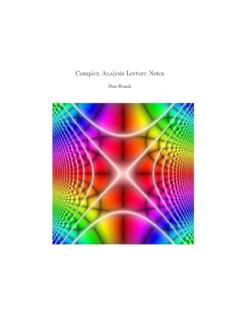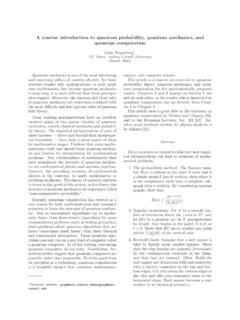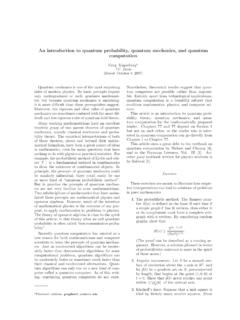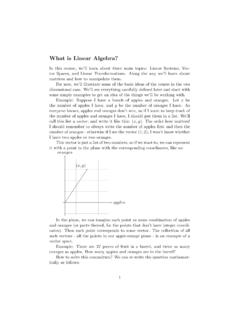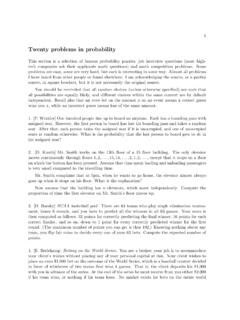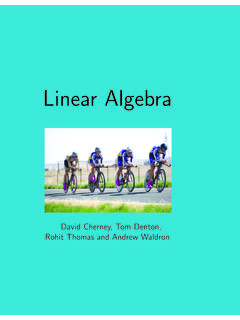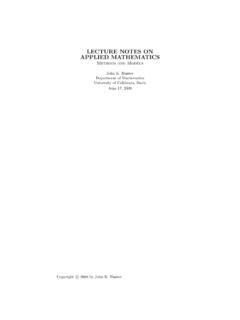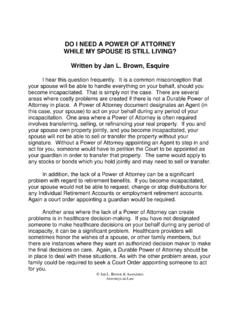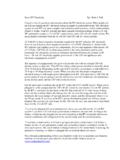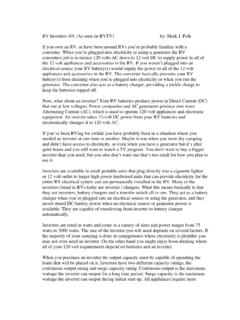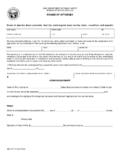Transcription of Power Series - UC Davis Mathematics :: Home
1 Chapter6 Power SeriesPower Series are one of the most useful type of Series in analysis. For example,we can use them to define transcendental functions such as the exponential andtrigonometric functions (and many other less familiar functions). IntroductionA Power Series (centered at 0) is a Series of the form n=0anxn=a0+a1x+a2x2+ +anxn+..where theanare some coefficients. If all but finitely many of theanare zero,then the Power Series is a polynomial function, but if infinitely many of theanarenonzero, then we need to consider the convergence of the Power basic facts are these: Every Power Series has a radius of convergence 0 R , which depends on the coefficientsan. The Power Series converges absolutelyin|x|< Rand diverges in|x|> R, and the convergence is uniform on every interval|x|< where 0 < R. IfR >0, the sum of the Power Series is infinitelydifferentiable in|x|< R, and its derivatives are given by differentiating the originalpower Series Series work just as well for complex numbers as real numbers, and arein fact best viewed from that perspective, but we restrict our attention here toreal-valued Power nition (an) n=0be a sequence of real numbers andc R.
2 The powerseries centered atcwith coefficientsanis the Series n=0an(x c) Power SeriesHere are some Power Series centered at 0: n=0xn= 1 +x+x2+x3+x4+.., n=01n!xn= 1 +x+12x2+16x3+124x4+.., n=0(n!)xn= 1 +x+ 2x2+ 6x3+ 24x4+.., n=0( 1)nx2n=x x2+x4 x8+..;and here is a Power Series centered at 1: n=1( 1)n+1n(x 1)n= (x 1) 12(x 1)2+13(x 1)3 14(x 1)4+..The Power Series in a formal expression, since we have not saidanything about its convergence. By changing variablesx7 (x c), we can assumewithout loss of generality that a Power Series is centered at 0, and we will do sowhen it s Radius of convergenceFirst, we prove that every Power Series has a radius of n=0an(x c)nbe a Power Series . There is an 0 R such that the Series converges absolutelyfor 0 |x c|< Rand diverges for|x c|> R. Furthermore, if 0 < R, thenthe Power Series converges uniformly on the interval|x c| , and the sum of theseries is continuous in|x c|< without loss of generality thatc= 0 (otherwise, replacexbyx c).
3 Suppose the Power Series n=0anxn0converges for somex0 Rwithx0 = 0. Then its terms converge to zero, so theyare bounded and there existsM 0 such that|anxn0| Mforn= 0,1,2,..If|x|<|x0|, then|anxn|=|anxn0| xx0 n Mrn, r= xx0 < the Power Series with the convergent geometric Series Mrn, we seethat anxnis absolutely convergent. Thus, if the Power Series converges for somex0 R, then it converges absolutely for everyx Rwith|x|<|x0|. Radius of convergence75 LetR= sup{|x| 0 : anxnconverges}.IfR= 0, then the Series converges only forx= 0. IfR >0, then the seriesconverges absolutely for everyx Rwith|x|< R, because it converges for somex0 Rwith|x|<|x0|< R. Moreover, the definition ofRimplies that the seriesdiverges for everyx Rwith|x|> R. IfR= , then the Series converges for allx , let 0 < Rand suppose|x| . Choose >0 such that < < |an n|converges, so|an n| M, and therefore|anxn|=|an n| x n |an n| n Mrn,wherer= / <1. Since Mrn< , theM-test ( ) implies thatthe Series converges uniformly on|x| , and then it follows from the sum is continuous on|x|.
4 Since this holds for every 0 < R, thesum is continuous in|x|< R. The following definition therefore makes sense for every Power nition the Power Series n=0an(x c)nconverges for|x c|< Rand diverges for|x c|> R, then 0 R is calledthe radius of convergence of the Power not say what happens at the endpointsx=c R, and ingeneral the Power Series may converge or diverge there. We refer to the set of allpoints where the Power Series converges as its interval of convergence, which is oneof(c R,c+R),(c R,c+R],[c R,c+R),[c R,c+R].We will not discuss any general theorems about the convergence of Power Series atthe endpoints ( the Abel theorem). not give an explicit expression for the radius of convergenceof a Power Series in terms of its coefficients. The ratio test gives a simple, but useful,way to compute the radius of convergence, although it doesn t apply to every thatan = 0 for all sufficiently largenand the limitR= limn anan+1 exists or diverges to infinity.
5 Then the Power Series n=0an(x c)nhas radius of Power limn an+1(x c)n+1an(x c)n =|x c|limn an+1an .By the ratio test, the Power Series converges if 0 r <1, or|x c|< R, anddiverges if 1< r , or|x c|> R, which proves the result. The root test gives an expression for the radius of convergence of a generalpower (Hadamard).The radius of convergenceRof the Power Series n=0an(x c)nis given byR=1lim supn |an|1=nwhereR= 0 if the lim sup diverges to , andR= if the lim sup is lim supn |an(x c)n|1=n=|x c|lim supn |an|1= the root test, the Series converges if 0 r <1, or|x c|< R, and diverges if1< r , or|x c|> R, which proves the result. This theorem provides an alternate proof of the root test; infact, our proof of more-or-less a proof of the root Examples of Power seriesWe consider a number of examples of Power Series and their radii of geometric Series n=0xn= 1 +x+x2+..has radius of convergenceR= limn 11= it converges for|x|<1, to 1/(1 x), and diverges for|x|>1.
6 Atx= 1, theseries becomes1 + 1 + 1 + 1 +..and atx= 1 it becomes1 1 + 1 1 + 1 ..,so the Series diverges at both endpointsx= 1. Thus, the interval of convergenceof the Power Series is ( 1,1). The Series converges uniformly on [ , ] for every0 <1 but does not converge uniformly on ( 1,1) (see Notethat although the function 1/(1 x) is well-defined for allx = 1, the Power seriesonly converges to it when|x|< Examples of Power series77 Example Series n=11nxn=x+12x2+13x3+14x4+..has radius of convergenceR= limn 1/n1/(n+ 1)= limn (1 +1n)= 1, the Series becomes the harmonic Series n=11n= 1 +12+13+14+..,which diverges, and atx= 1 it is minus the alternating harmonic Series n=1( 1)nn= 1 +12 13+14 ..,which converges, but not absolutely. Thus the interval of convergence of the powerseries is [ 1,1). The Series converges uniformly on [ , ] for every 0 <1 butdoes not converge uniformly on ( 1,1).Example Power Series n=01n!xn= 1 +x+12!x+13!x3+..has radius of convergenceR= limn 1/n!]
7 1/(n+ 1)!= limn (n+ 1)!n!= limn (n+ 1) = ,so it converges for allx R. Its sum provides a definition of the exponentialfunction exp :R R. (See )Example Power Series n=0( 1)n(2n)!x2n= 1 12!x2+14!x4+..has radius of convergenceR= , and it converges for allx R. Its sum providesa definition of the cosine function cos :R Series n=01( 1)n(2n+ 1)!x2n+1=x 13!x3+15!x5+..has radius of convergenceR= , and it converges for allx R. Its sum providesa definition of the sine function sin :R Power Series n=0(n!)xn= 1 +x+ (2!)x+ (3!)x3+ (4!)x4+..786. Power of the lacunary Power seriesy= 1n=0( 1)nx2non [0,1).It appears relatively well-behaved; however, the small oscillations visible nearx= 1 are not a numerical radius of convergenceR= limn n!(n+ 1)!= limn 1n+ 1= 0,so it converges only forx= 0. Ifx = 0, its terms grow larger oncen >1/|x|and|(n!)xn| asn .Example Series n=1( 1)n+1n(x 1)n= (x 1) 12(x 1)2+13(x 1)3 ..has radius of convergenceR= limn ( 1)n+1/n( 1)n+2/(n+ 1) = limn nn+ 1= limn 11 + 1/n= 1,so it converges if|x 1|<1 and diverges if|x 1|>1.]
8 At the endpointx= 2, thepower Series becomes the alternating harmonic series1 12+13 14+..,which converges. At the endpointx= 0, the Power Series becomes the harmonicseries1 +12+13+14+..,which diverges. Thus, the interval of convergence is (0,2]. Differentiation of Power series79 Example Power Series n=0( 1)nx2n=x x2+x4 x8+x16 x32+..withan={1 ifn= 2k,0 ifn = 2k,has radius of convergenceR= 1. To prove this, note that the Series converges for|x|<1 by comparison with the convergent geometric Series |x|n, since|anxn|={|x|nifn= 2k,0 |x|nifn = |x|>1, the terms do not approach 0 asn , so the Series diverges. Alterna-tively, we have |an|1=n={1 ifn= 2k,0 ifn = 2k,solim supn |an|1=n= 1and the root test ( ) givesR= 1. The Series does not converge at eitherendpointx= 1, so its interval of convergence is ( 1,1).There are successively longer gaps (or lacuna ) between the powers with non-zero coefficients. Such Series are called lacunary Power Series , and they have manyinteresting properties.)}}}
9 For example, although the Series does not converge atx= 1,one can ask iflimx 1 [ n=0( 1)nx2n]exists. In a plot of this sum on [0,1), shown in Figure1, the function appearsrelatively well-behaved nearx= 1. However, Hardy (1907) proved that the functionhas infinitely many, very small oscillations asx 1 , as illustrated in Figure2,and the limit does not exist. Subsequent results by Hardy and Littlewood (1926)showed, under suitable assumptions on the growth of the gaps between non-zerocoefficients, that if the limit of a lacunary Power Series asx 1 exists, then theseries must converge atx= 1. Since the lacunary Power Series considered here doesnot converge at 1, its limit asx 1 cannot Differentiation of Power seriesWe saw in , in general, one cannot differentiate a uniformly con-vergent sequence or Series . We can, however, differentiate Power Series , and theybehaves as nicely as one can imagine in this respect. The sum of a Power seriesf(x) =a0+a1x+a2x2+a3x3+a4x4+.]
10 Is infinitely differentiable inside its interval of convergence, and its derivativef (x) =a1+ 2a2x+ 3a3x2+ 4a4x3+..806. Power of the lacunary Power Series 1n=0( 1)nx2nnearx= 1,showing its oscillatory behavior and the nonexistence of a limit asx!1 .is given by term-by-term differentiation. To prove this, we first show that theterm-by-term derivative of a Power Series has the same radius of convergence as theoriginal Power Series . The idea is that the geometrical decay of the terms of thepower Series inside its radius of convergence dominates the algebraic growth of that the Power Series n=0an(x c)nhas radius of convergenceR. Then the Power Series n=1nan(x c)n 1also has radius of without loss of generality thatc= 0, and suppose|x|< R. Choose such that|x|< < R, and letr=|x| ,0< r < estimate the terms in the differentiated Power Series by the terms in the originalseries, we rewrite their absolute values as follows: nanxn 1 =n (|x| )n 1|an n|=nrn 1 |an n|.
